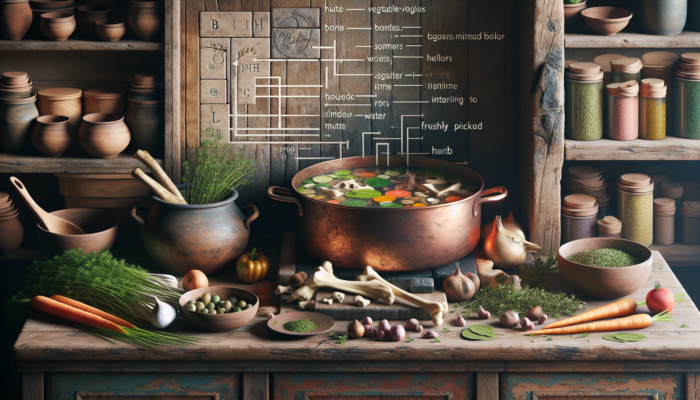Discover How to Create Flavorful Homemade Stock Using Kitchen Scraps for Maximum Sustainability
Learning the art of crafting your own homemade stock is an essential culinary expertise that not only elevates the flavor of your meals but also supports eco-friendly practices in your cooking routine. By mastering the technique of making homemade stock from scraps, you can enhance the taste of your dishes while drastically reducing food waste, benefiting both your kitchen and the environment. Let’s explore the key components that will prepare you for an enriching experience in producing savory stock.
Why Fresh Ingredients Matter for Top-Quality Stock

The quality of your ingredients is vital to achieving exceptional stock. Employing fresh scraps guarantees a robust and flavorful stock, serving as a perfect base for various culinary delights, ranging from hearty soups to exquisite sauces. Fresh vegetable scraps such as onion skins, carrot tops, and celery leaves impart vibrant flavors and essential nutrients that elevate the overall taste of your stock. Similarly, fresh meat scraps, including bones and trimmings, contribute a deeper, more nuanced flavor profile. Always prioritize using scraps from freshly sourced produce and meats, as spoiled or wilted ingredients can severely compromise both the taste and safety of your stock.
Essential Ingredients for Crafting Outstanding Stock
Embarking on your stock-making adventure requires a focus on simplicity and quality. The crucial ingredients needed include water, an assortment of vegetables, and meat scraps. Water serves as the primary base, acting as a conduit to extract flavors from your scraps. For vegetables, opt for commonly discarded items like onion skins, carrot peels, and garlic cloves. If you're preparing meat stock, bones and trimmings from chicken, beef, or other meats provide the essential flavor backbone. Additionally, incorporating herbs like parsley, thyme, or bay leaves can significantly enhance the aroma and flavor of your stock, making it truly delightful.
Understanding Cooking Time and Temperature for Perfect Stock
The success of your stock hinges on effectively managing the cooking time and temperature. It is crucial to allow the stock to simmer gently for at least 2 hours at a low temperature. This slow cooking method allows flavors to harmonize beautifully while extracting maximum nutrients from the scraps. Overheating can result in a bitter taste and undesirable cloudiness, so it’s essential to keep the heat low and maintain a gentle simmer throughout the cooking duration. For meat-based stocks, consider extending the cooking time to at least 4 hours or more, especially when utilizing larger bones, to ensure that every bit of flavor is captured.
Your Complete Step-by-Step Guide to Crafting Homemade Stock from Kitchen Scraps

Creating stock from scraps is a straightforward process that anyone can master with ease. Follow this comprehensive step-by-step guide to ensure your stock is brimming with flavor and nutrients.
Strategically Collecting and Storing Your Kitchen Scraps
Begin by gradually accumulating both vegetable and meat scraps over time. Designate a specific container in your fridge or freezer to store these scraps. This container may hold onion peels, carrot tops, celery leaves, and any meat trimmings you might have on hand. The beauty of this approach lies in the ability to build up a collection of scraps over time, making stock-making a convenient and environmentally friendly endeavor. Aim to gather enough to fill a large pot when you’re ready to prepare your stock, ensuring that you are well-equipped for the cooking process.
Preparing Your Cooking Pot for Efficient Stock Production
Once you have gathered your scraps, it’s time to prepare your pot for cooking. Choose a large pot that can comfortably accommodate all your scraps and water without risk of overflowing. A dedicated stockpot is ideal, but any large pot will do. Add your vegetable and meat scraps into the pot, ensuring a balanced mix for optimal flavor extraction. Fill the pot with cold water, covering the scraps by about an inch. Starting with cold water is crucial as it helps extract flavors more efficiently during the cooking process, leading to a richer final product.
Simmering Your Stock to Achieve Maximum Flavor Infusion

Place your pot on the stove and bring it to a gentle boil. As soon as it reaches boiling point, reduce the heat to low to maintain a gentle simmer, which is crucial in the stock-making process. Allow it to simmer for a minimum of 2 hours, stirring occasionally to prevent sticking at the bottom. For meat stocks, consider simmering for 4 hours or longer. As the stock simmers, you’ll notice it transforming into a beautiful golden hue, while a rich aroma fills your kitchen. This slow simmering technique allows the flavors to meld together, resulting in a delicious and nutritious base for your culinary creations.
Straining Your Stock for Clarity and Enhanced Taste
Once the simmering process is complete, it’s time to strain the stock. Carefully remove the pot from the heat and allow it to cool slightly. Using a fine mesh strainer or a cheesecloth, strain the stock into another pot or bowl, discarding the solids. This vital step is essential for achieving clarity and a refined flavor in your stock. If you seek an even clearer stock, consider straining it multiple times. Once strained, allow the stock to cool completely before storing it in the fridge or freezer to maintain its freshness and taste.
Explore the Advantages of Utilizing Kitchen Scraps for Homemade Stock
Crafting stock from scraps is not just a sustainable practice; it offers numerous benefits that make it a smart choice for any home cook looking to enhance their culinary repertoire.
Economically Benefit While Reducing Food Waste
Utilizing scraps effectively minimizes food waste while also saving you money. Rather than purchasing pre-made stock or broth, you can easily create your own using ingredients that would otherwise be discarded. This budget-friendly approach is particularly advantageous for those who are cost-conscious or anyone striving to be more mindful of their grocery expenditures. By repurposing scraps, you ensure that every part of your food contributes to a delightful meal, making your cooking practices more economical and efficient.
Enhance the Nutritional Value of Your Meals with Homemade Stock
Another significant benefit of creating stock from scraps is the enhanced nutritional value it brings to your dishes. Vegetable scraps often contain vitamins and minerals that can boost the health benefits of your stock. For example, carrot tops are rich in vitamin C and dietary fiber, while onion skins are a source of antioxidants. Moreover, meat scraps, particularly bones, are abundant in collagen, which is beneficial for joint health. Thus, the stock you prepare not only amplifies flavor but also acts as a nutritious enhancer in your meals.
Make a Positive Environmental Impact Through Sustainable Practices
Using scraps for homemade stock significantly contributes to reducing landfill waste, making it an environmentally responsible choice. By maximizing your food use, you help create a more sustainable kitchen while lowering your overall carbon footprint. This practice promotes a mindset of resourcefulness and sustainability that can extend beyond the kitchen. By sharing your stock-making journey with others, you can inspire a collective movement towards reducing food waste in your community, fostering sustainable cooking practices that benefit everyone involved.
Identifying the Best Types of Scraps for Flavorful Stock
Selecting the right scraps is essential for concocting a delicious and aromatic stock. Here’s a thorough breakdown of the best types of scraps to utilize for optimal flavor extraction.
Elevate Flavor with Quality Vegetable Scraps
Vegetable scraps serve as the foundation of a flavorful stock. Ingredients like onion skins, carrot tops, garlic cloves, and celery leaves are among the most effective options to consider. These components contribute depth and sweetness to your stock, creating a robust base for soups and sauces. Additionally, you can introduce herbs such as parsley stems, thyme, and bay leaves to infuse your stock with aromatic qualities. Experimenting with various combinations allows you to discover your preferred flavor profile, ensuring that your stock is both distinctive and delicious.
Achieving Depth with Quality Meat Scraps
For those aiming to produce a rich meat stock, incorporating bones and meat trimmings is essential. Chicken carcasses, beef bones, and pork scraps work beautifully, providing a depth of flavor that vegetable scraps alone cannot deliver. Roasting the bones before adding them to your stock can intensify their flavor, imparting a caramelized note to your final product. The collagen released from the bones during the simmering process adds both body and richness to your stock, making it an indispensable component for hearty soups and stews.
Enhance Flavor with Herb Scraps
Herb scraps, often overlooked, can elevate your stock to new heights. Stems from fresh herbs like parsley, cilantro, and thyme add a fragrant aroma that enhances the overall taste of your stock. You can also experiment with stronger herbs like rosemary or sage to impart a distinct character to your stock. Remember, achieving a flavor balance is crucial; use herb scraps wisely to avoid overpowering the other ingredients.
Effective Strategies for Storing and Freezing Your Homemade Stock
Once you’ve successfully crafted your stock, proper storage is essential for preserving its freshness and flavor. Here are some practical strategies for storing and freezing your homemade stock.
Rapid Cooling Techniques for Stock Safety
Before storing your stock, it’s vital to cool it quickly to prevent bacterial growth. Divide the hot stock into smaller portions in shallow containers to facilitate rapid cooling. Additionally, placing the containers in an ice bath can expedite the cooling process. Once the stock reaches room temperature, transfer it to the fridge if you plan to use it within a few days, or proceed to freeze it for long-term storage.
Freezing Stock in Convenient, Usable Portions
Freezing your stock in manageable portions ensures you have it readily available when needed. Ice cube trays are perfect for this purpose; simply pour the cooled stock into the trays, freeze, and then transfer the cubes to a freezer bag. This method allows you to defrost only the amount required for your recipes, significantly reducing waste and ensuring that your stock maintains its quality over time.
Labeling and Dating Frozen Stock to Ensure Freshness
Always label and date your frozen stock to keep track of its freshness. This simple yet effective measure can save you from the disappointment of discovering that your stock has been in the freezer for too long. Typically, homemade stock can be stored in the freezer for up to six months. After this period, the flavor may diminish, so be mindful of your inventory and utilize it within this timeframe for optimal results.
Common Mistakes to Avoid When Making Stock
While the process of making stock is relatively straightforward, there are common pitfalls that can lead to subpar results. Avoiding these errors will ensure your stock is both delicious and nutritious.
The Risks of Overcooking Your Stock
One of the most frequent mistakes people make is overcooking the stock. While it might seem logical that a longer cooking time would yield a more flavorful stock, overcooking can lead to a bitter taste. Aim for a gentle simmer, closely monitoring the cooking time. For vegetable stock, 2 to 3 hours is typically sufficient, while meat stocks may require 4 hours or longer. Trust the process and avoid rushing to achieve the best flavor possible.
Ensuring Freshness: Avoiding Spoiled Scraps
Another critical mistake is the use of spoiled scraps, which can ruin the flavor of your stock and pose safety risks. Always inspect your vegetable and meat scraps before incorporating them into the pot. If any scraps show signs of spoilage, it's advisable to discard them rather than risk compromising the quality of your stock. Freshness is paramount, so be diligent in selecting your ingredients to ensure a safe and tasty outcome.
The Importance of Skimming Impurities from Your Stock
Neglecting to skim off impurities during the cooking process can result in a cloudy stock. As the stock simmers, various impurities will rise to the surface. Use a ladle or skimmer to remove these impurities, leading to a clearer, more refined stock. This step not only enhances the appearance but also improves the flavor, making your stock more visually appealing and enjoyable to consume.
Innovative Culinary Applications for Your Homemade Stock
Once you’ve mastered the technique of making stock from scraps, the next step is to utilize it creatively in various recipes. Here are some inspiring ideas to elevate your culinary creations.
Creating Hearty Soups and Stews with Homemade Stock
Your homemade stock serves as an exceptional foundation for crafting hearty soups and stews. Whether you’re preparing a classic chicken soup or a robust beef stew, incorporating your stock adds a depth of flavor that store-bought options simply cannot match. Experiment with diverse ingredients and spices to create dishes that reflect your unique tastes and culinary style.
Enhancing Sauces and Gravies Using Your Homemade Stock
Elevate your sauces and gravies by incorporating the rich flavor profile of homemade stock. Whether creating a simple pan sauce or a complex gravy for a roast, substituting stock for water or store-bought broth will elevate your dish to new culinary heights. The depth of flavor in your stock will shine through, making your sauces more robust and delicious, providing a delightful experience for your diners.
Infusing Flavor into Risotto and Rice Dishes with Stock
Using stock as the cooking liquid for risotto or rice dishes introduces incredible depth of flavor. Instead of plain water, replace it with your homemade stock for a richer and more satisfying meal. The stock will infuse the grains with its flavor, ensuring that each bite is a delight. This technique is wonderfully effective for any rice dish, from pilafs to paellas, enhancing the overall dining experience.
Utilizing Stock for Braising Meats for Optimal Tenderness
Your homemade stock is ideal for braising meats, providing both flavor and moisture for a tender end result. Whether braising beef, pork, or chicken, using your stock as the braising liquid guarantees that the meat absorbs all the delicious flavors. The result is a succulent dish that showcases the effort you invested in creating your stock, impressing everyone at your table.
Understanding the Environmental Benefits of Crafting Stock from Kitchen Scraps
Creating stock from scraps is not just a practical cooking method; it also provides substantial environmental benefits. Here’s how your kitchen efforts can positively impact the planet.
Significantly Reducing Food Waste
By making stock from scraps, you actively participate in reducing food waste. Each year, an astonishing amount of food is discarded, contributing to landfill overflow and greenhouse gas emissions. By repurposing scraps that would otherwise go to waste, you make a conscious decision to minimize your environmental impact while making the most of your resources.
Lowering Your Overall Carbon Footprint
Every bit of food waste that ends up in a landfill contributes to your carbon footprint. By utilizing scraps for homemade stock, you help reduce your carbon emissions. The more we can do to cut down on waste, the smaller our overall environmental impact becomes. This small change in your cooking habits can lead to significant improvements in sustainability, making a meaningful difference.
Encouraging Sustainable Cooking Practices in Your Community
Sharing your knowledge about making stock from scraps can inspire others to adopt sustainable cooking practices. By demonstrating how easy and beneficial it is to repurpose kitchen scraps, you foster a culture of mindfulness surrounding food consumption. This ripple effect can lead to broader community initiatives focused on reducing food waste and promoting sustainability, creating a more responsible approach to cooking.
Building Community Connections Through Sustainable Cooking Efforts
Lastly, discussing your stock-making tips and experiences within your community can cultivate a sense of shared responsibility towards sustainability. Encouraging neighbors and friends to adopt similar practices can establish a supportive network aimed at reducing waste and embracing sustainable cooking. This collective effort can result in a more environmentally conscious community, benefiting everyone involved and fostering a culture of sustainability.
Frequently Asked Questions (FAQs)
Are all vegetable scraps suitable for stock-making?
You can use a variety of vegetable scraps, but focus on flavorful options such as onion skins, carrot tops, and celery leaves. Avoid using bitter vegetables or those that spoil quickly, as they can negatively impact the flavor of your stock.
How long can homemade stock be safely stored in the refrigerator?
Homemade stock can typically be stored in the refrigerator for up to 3-4 days. If you don’t plan to use it within that timeframe, freezing it is recommended for longer-term preservation.
Is it safe to use meat scraps for stock-making?
Absolutely! Using fresh meat scraps, bones, and trimmings is safe and adds richness to your stock. Ensure they are fresh and handled properly to avoid any food safety issues.
Can I create stock without using meat?
Definitely! Vegetable stock can be just as flavorful and nutritious as meat stock. Focus on utilizing a variety of vegetables and herbs to create a flavor depth that will satisfy your palate.
What’s the best method to thaw frozen stock?
The most effective way to thaw frozen stock is to transfer it to the refrigerator the night before you intend to use it. You can also thaw it in a microwave or by placing the container in warm water, ensuring it’s ready for your cooking needs.
Can I reuse scraps for making stock?
While you can reuse some vegetable scraps, they may lose flavor after the first batch. It’s best to use fresh scraps for optimal results in subsequent batches to maintain the quality and taste of your stock.
How can I tell if my stock has gone bad?
If your stock develops an off smell, unusual color, or any signs of mold, it’s best to discard it. Always trust your senses to ensure food safety and quality.
Is it okay to add spices during the stock cooking process?
Yes! Adding spices like peppercorns, bay leaves, and herbs while cooking can enhance the flavor profile of your stock. Just remember to strain them out before storing to maintain a clear stock.
Is homemade stock more nutritious than store-bought options?
Homemade stock often contains higher nutrients and flavor compared to store-bought varieties, as you control the ingredients and can include nutrient-rich scraps that enhance the final product.
Can stock be made in a slow cooker?
Yes, making stock in a slow cooker is an excellent option. Simply add your scraps and water, set it on low, and let it simmer for several hours for a rich and flavorful stock.
Connect with us on Facebook!
The post Homemade Stock: Easy Guide Using Kitchen Scraps appeared first on https://cookinggods.com
The Article Easy Guide to Homemade Stock from Kitchen Scraps Was Found On https://limitsofstrategy.com


I loved diving into your exploration of homemade stock! It’s such a simple yet transformative technique that really ties into the whole ‘nose-to-tail’ or ‘root-to-leaf’ approach that’s becoming so popular in sustainable cooking. It reminds me of my own journey over the past few years as I’ve shifted towards being more conscious of my cooking habits and the waste I produce.
I really appreciate your thoughts on homemade stock. It’s fascinating how something so basic can have such a significant impact, both on flavor and on minimizing waste. The connection to the ‘nose-to-tail’ and ‘root-to-leaf’ concepts really highlights how cooking can be both resourceful and delicious. It’s a win-win when we can create rich, satisfying meals while respecting the ingredients we have.
Thank you so much for your kind words! It’s inspiring to hear about your journey towards more conscious cooking. If you’re interested in exploring more sustainable techniques and recipes, check out this resource I found helpful. It really aligns with the values we discussed!
https://plumberchoices.co.uk/emailoctopus
It’s great to hear that my thoughts on homemade stock resonated with you. The way cooking connects us to the ingredients and the journey of sustainability feels so important these days. Your shift towards more conscious cooking habits is inspiring. There’s something truly rewarding about taking a more thoughtful approach, whether it’s reducing waste or finding creative ways to use parts of ingredients that might usually end up discarded.
I’m so glad to hear you enjoyed it! If you’re interested in diving deeper into sustainable cooking habits, I recently put together some resources that might inspire your journey even further. Check it out here!
https://plumberchoices.co.uk/PhotoLeap
It’s great to hear that you’re diving into the world of sustainable cooking! Homemade stock really does take things to another level, doesn’t it? It’s all about getting the most out of what we have. I remember when I first started, I was amazed at how a few scraps and some water could transform into something rich and flavorful.
It’s interesting how something as simple as a few scraps can lead to such rich flavors. I still recall the first time I made stock; I had saved vegetable peels and herb stems, thinking they’d just go to waste. But watching the transformation as everything simmered was almost magical.
It’s encouraging to hear your experience with stock-making. Those kitchen scraps often hold so much potential that we might overlook. When you think about it, it’s a great way of turning what could end up in the trash into something nourishing.
“Absolutely, it’s amazing how those humble ingredients can create something so flavorful! If you’re looking to elevate your stock game even further, check out this guide I put together on maximizing those kitchen scraps.”
https://plumberchoices.co.uk/consult
It’s true—the transformation that occurs from a handful of scraps and water into a rich, flavorful stock is really something special. I often think about how that simple process not only enhances the taste of whatever dish you’re preparing but also makes efficient use of what might otherwise be discarded.
Absolutely, it’s incredible how simple ingredients can create such depth of flavor! If you’re looking to expand your sustainable cooking journey even further, check out this resource for more tips and recipes.
https://plumberchoices.co.uk/PhotoLeap